There are no definitive “growth hacks” for increasing your Instagram followers — but don't worry, there are still plenty of practical things you can do to build a solid growth strategy that actually works.
Here are 14 steps you can take for organic Instagram growth in the order we recommend doing them.
Before we dive in: If you’re just starting with Instagram for your business or as a creator, the first step is to tighten the nuts and bolts of your Instagram presence. The first few tips in this guide cover the basics and are especially helpful if you're just starting out as a creator or business.
Even if you’re a seasoned Instagrammer, it’s worth double-checking that you’ve got the fundamentals covered before moving on. If you are, don't worry: there's plenty of guidance in this guide for intermediate and advanced creators, too.
We know it's tempting to buy fake followers for a quick boost, but it'll actually work against you in the long run. These tips will be a far better use of your time — and will be well worth the effort.
Let's get into them all.
Overview: 14 ways to get more Instagram followers
- 1. Add keywords to your username and name
- 2. Optimize your Instagram bio
- 3. Cross-promote your Instagram handle on other channels
- 4. Build an Instagram marketing strategy
- 5. Post 3-5 times per week
- 6. Find your best times to post on Instagram
- 7. Write compelling captions
- 8. Use relevant hashtags and keywords
- 9. Understand your analytics
- 10. Collaborate with Instagram creators or other small businesses
- 11. Experiment with different types of Instagram posts
- 12. Talk to your audience in comments and stories
- 13. Avoid buying fake followers
- 14. Get verified on Instagram
1. Add keywords to your username and name
The Instagram algorithm prioritizes search results containing keywords in the name and username.
- Your username is your Instagram handle (your profile’s @name): Keep this the same as your company’s name and/or consistent with your profile’s username on other social channels to be instantly identifiable.
- Your name is your or your company’s name (or anything you like): Add relevant keywords here that your target audience would search for to improve your visibility.
For example, creator Hannah Hargrove has the keywords “Baby + Toddler Nutrition” on her Instagram account, right next to her name. Her username is also “tinyeatersnutrition” — these specifics instantly tell you what to expect from her Instagram account.
Instagram users searching for “toddler nutrition” will also find her account pop up in search (that’s how I found her!) — helping her gain more Instagram followers.
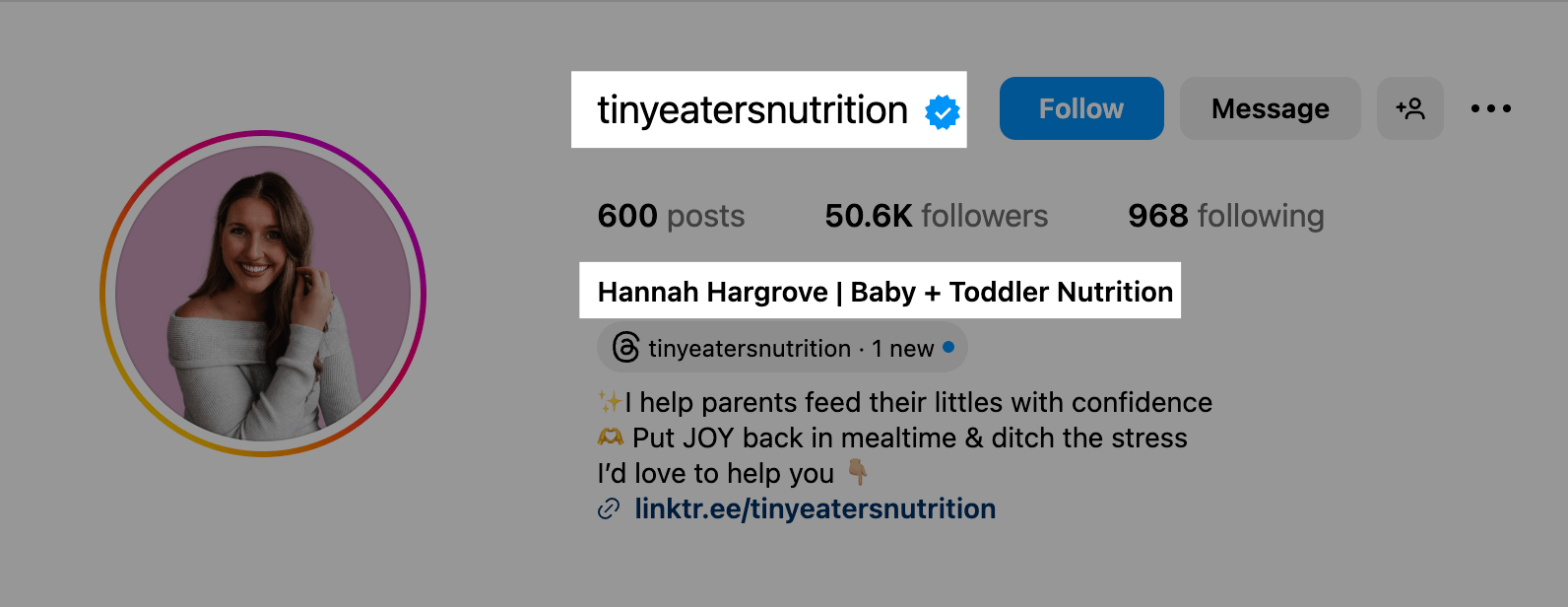
Adding relevant keywords is also an opportunity to share who you are and what you sell to new followers at a glance — since it's the first thing someone sees when they land on your profile.
Just don't go overboard with keywords in your Instagram name field — it'll come across as spammy and water down their purpose. Use just a few phrases that tell people what your Instagram account is about.
2. Optimize your Instagram bio
When you think of how to get more followers on Instagram, you might not think of the Instagram bio. But the bio is a crucial part of your Instagram feed — it tells other Instagram users who you are and what you do in a few sentences.
There are four elements you need to nail to for the perfect Instagram bio:
- A straightforward description of what you do and/or what you sell
- A touch of brand personality
- A clear call to action
- A link
Want to show up in more searches? Add one or two keywords that describe what you do right in your name field or handle — think “vegan recipes” or “wedding photographer.” Those words act like SEO for Instagram, making it easier for the right people to find you.
The key to great Instagram bios is making them clear, creative, and complete. Anyone reading it should instantly know what you do or your company does, how it can help them, and where they can learn more.
The skincare company, Kinship, is an excellent example of how to ace the Instagram bio.
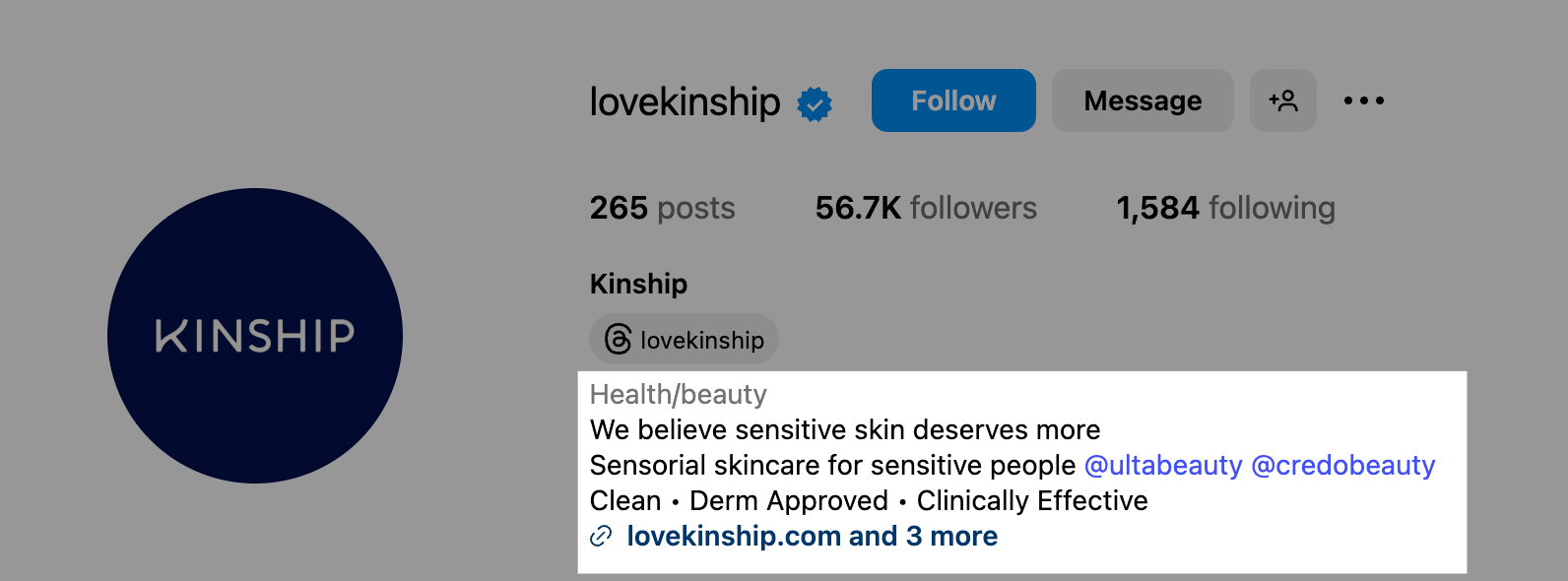
They use the right Instagram category for their account (health/beauty) to instantly establish their niche. Following this is one line about their brand mentions, another about what they sell, and the last one about their strongest features.
In the end, they’ve added multiple links for their Instagram followers to tap on and learn more.
The link in bio is your chance to redirect your Instagram followers to an external page. You can add your company’s website or keep updating it based on your recent Instagram posts.
But if you want to go the extra mile, use link-in-bio tools like Buffer’s Start Page to combine all your URLs into one landing page — like photographer Ryan Johnson:
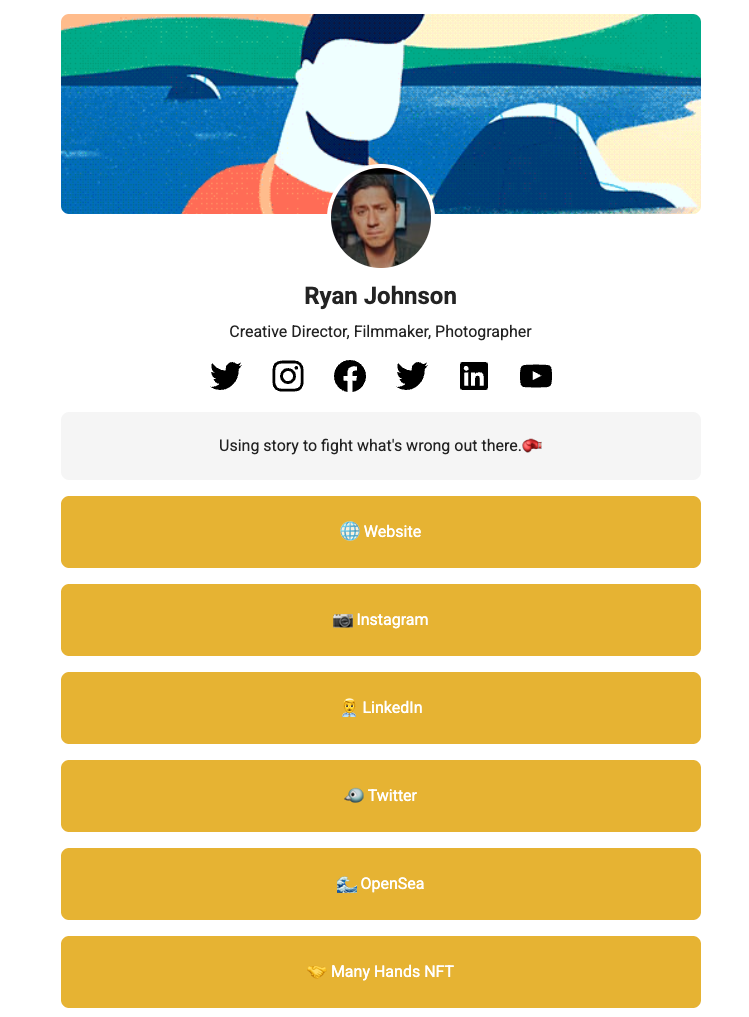
You can customize this Start Page using Buffer as much as you like to make it more on-brand for your Instagram followers. There are in-depth statistics about link clicks for each URL, too.
3. Cross-promote your Instagram handle on other channels
Redirecting potential customers from other channels to your Instagram account is an easy way to gain more Instagram followers quickly — especially if you already have a strong presence on other social media platforms.
For example, at Buffer, we have our Instagram link on our website footer.
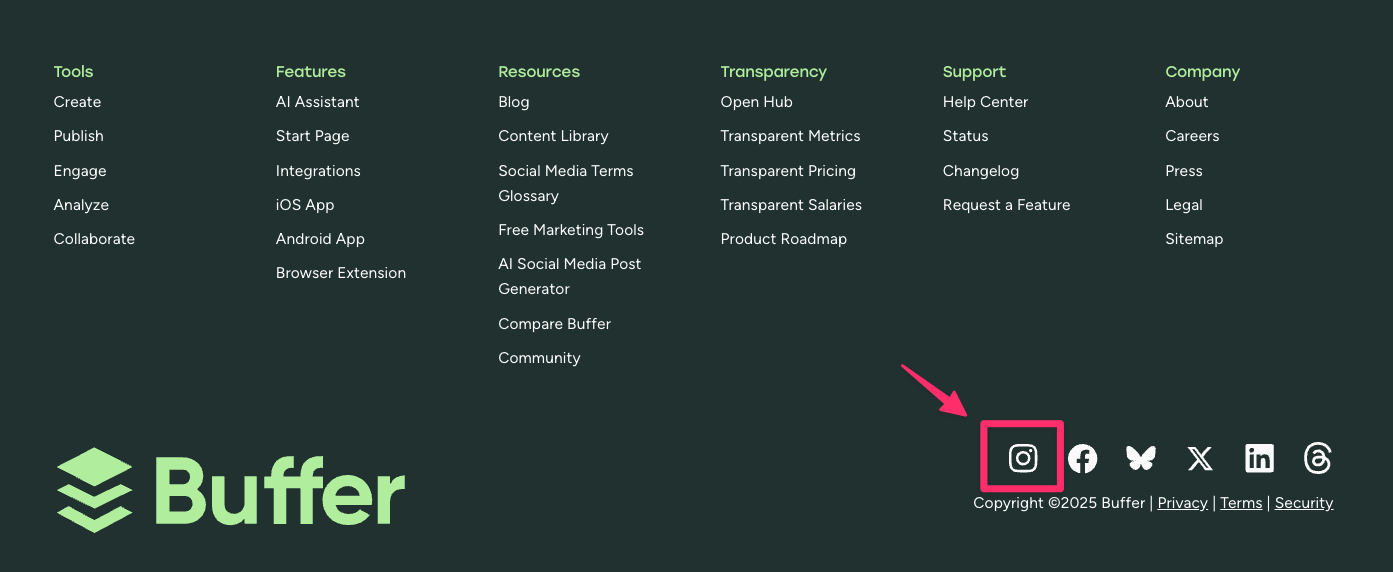
There are various ways to cross-promote to increase your follower count. Add your Instagram page’s link to:
- Your product packaging
- Your blogs (when relevant)
- Marketing and transactional emails
- Your website’s footer and/or sidebar
- Social media posts from team members
- Your and your employees’ email signature
- Bios on other social media platforms like TikTok and YouTube
- Networking events and webinars (Use your profile’s Instagram QR code for in-person events)
Cross-promotion will help you increase the probability of being in front of relevant users on Instagram. Existing followers from other social media platforms likely already know you and the kind of content you create — they’re quality followers; the ones who are most likely to enjoy and engage with your Instagram posts.
4. Build an Instagram strategy
Having a clear idea of where Instagram fits into your overall social media marketing strategy will not only help you gain more followers, but also help you get more relevant content ideas for Instagram.
But how do you create an Instagram growth strategy?
Step 1: Get clear on your goals
Instead of learning how to get more followers on Instagram, step back and reflect on what you plan to do with your follower count.
Do you want to build a personal brand? Or raise brand awareness for your company? Perhaps you want to drive website traffic. Maybe you want to collect more user-generated content.
Whatever it is, define it clearly — with measurable milestones — to put intention behind your Instagram strategy. Clarifying your goal dictates the content you post and calls to action, and keeps your Instagram feed on-brand.
Step 2: Get a 360-view of your target audience
Knowing the basic demographics is crucial. But also go beyond that and deeply understand what your audience struggles with and how you can help them resolve their challenges using your Instagram content strategy.
This will allow you to create content that truly resonates with your community — helping you gain more Instagram followers.
Natasha Pierre — creator and host of the Shine Online Podcast — says losing sight of your ideal follower in exchange for virality is the single biggest mistake creators make.
“People often focus so much on going viral and reaching as many people as possible that they lose sight of the ideal follower they're trying to reach,” she says.
“You could go viral today, and if you're reaching mostly the wrong people, chances are it won't result in them following you. [Even if they do], it would lead to Instagram followers who aren’t engaged.”
“Taking the time to reflect on who your ideal follower is will help you create specific-to-them content, which will not only result in better growth but quality new followers.”
Step 3: Define your brand voice and aesthetic
Even if you’re a creator and not a company, it’s worth crafting a social media marketing voice that’s uniquely you, so Instagram users can identify your posts without seeing the username.
Brand voice is hard to track or quantify, but it’s non-negotiable to be memorable. On Instagram, you can also define your aesthetic along with your brand voice. Use brand colors, stick to a consistent content theme, and have a personality.
Step 4: Create content pillar themes and stick to them
Decide on a niche for your Instagram account. Have a few overarching topics you’ll post about, and don’t deviate from them too much. This has many benefits:
- You don’t have to constantly reinvent the wheel for brainstorming great content ideas
- Your Instagram community starts recognizing you for the type of content you create
- You don’t get distracted by the new, shiny thing, and keep revising your Instagram strategy
5. Post 3–5 times per week for consistent growth
When it comes to growing on Instagram, frequency does matter. Buffer’s data shows that posting 3–5 times per week is the sweet spot for reach and follower growth in 2026.
We analyzed over two million Instagram posts and found that accounts posting 3–5 times per week:
- Grow their followers 2× faster than accounts posting 1–2 times
- See 12% more reach per post on average
That’s a big payoff for just one or two extra posts a week.
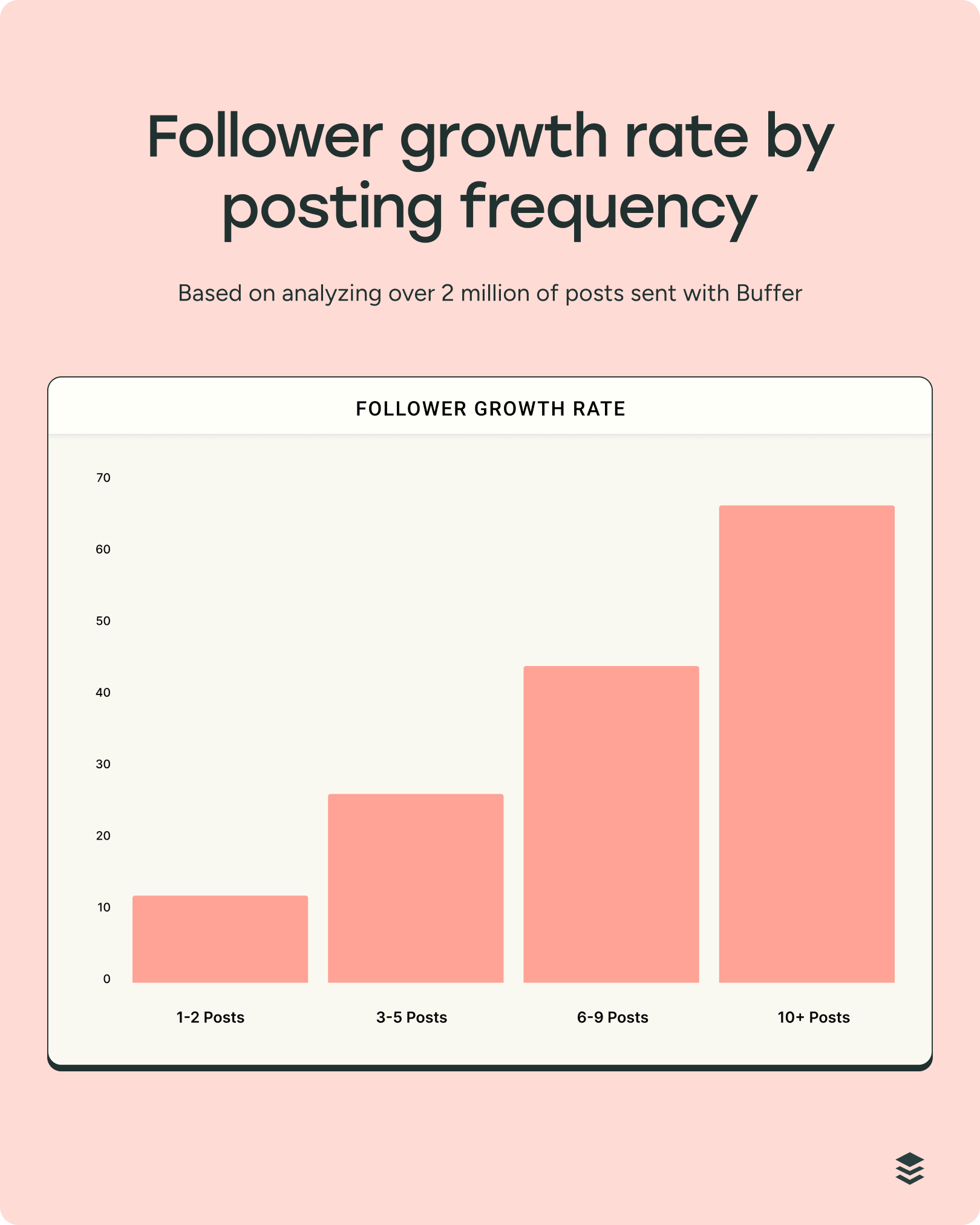
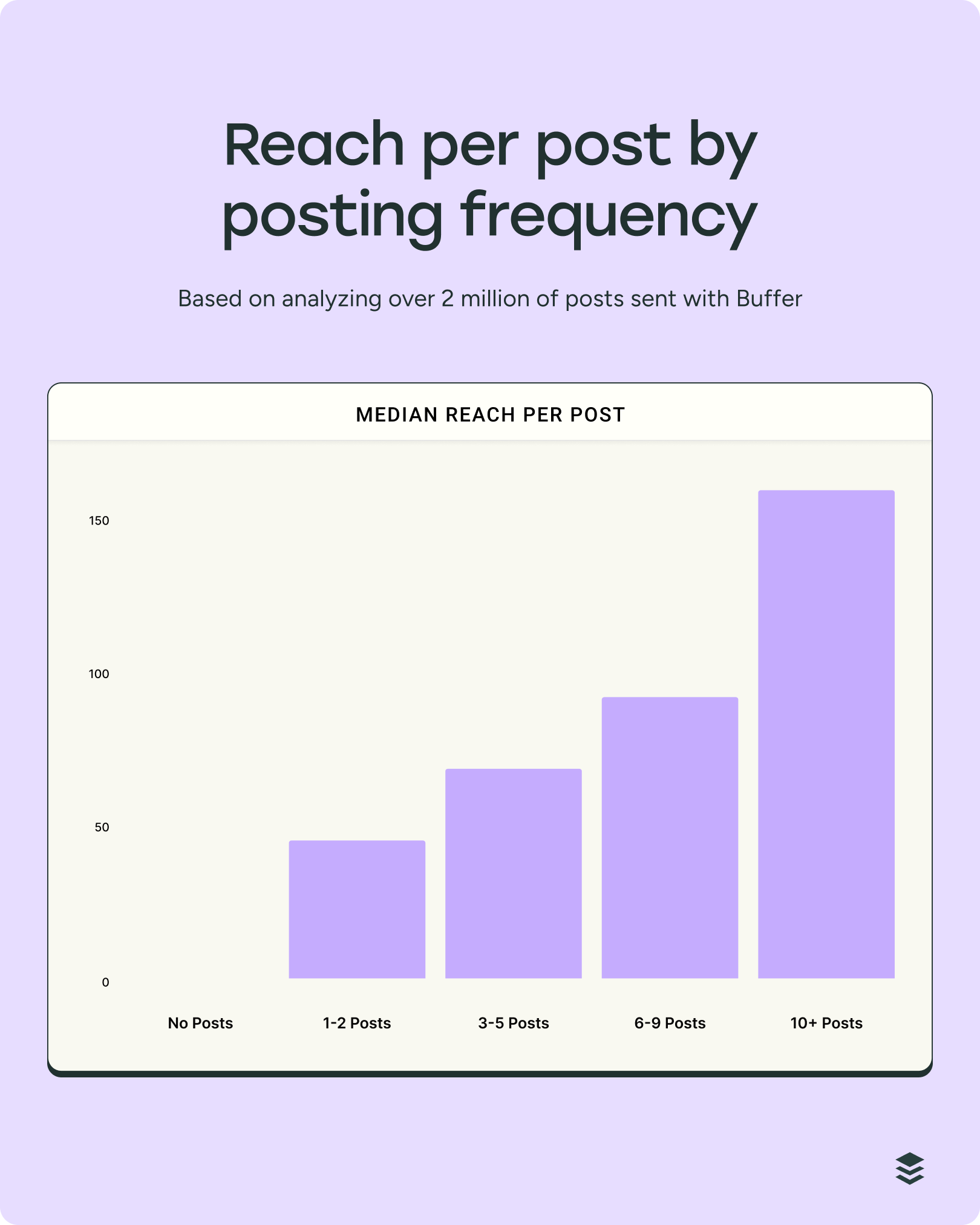
Every post you share is another chance to appear on the home feed, Explore tab, or reels feed — and reach new audiences. It's a bit like buying more lottery tickets (where the jackpot is a standout post that brings in loads of engaged new follower).
If you’re able to share more often — say 6–9 times weekly — that’s even better for growth. But if your time or creative energy is limited, aiming for 3–5 high-quality posts per week is a great, sustainable goal.
A smarter way to create more content sustainably is to repurpose your existing content. This doesn’t just mean repurposing content you’ve posted on previous channels (though that is a great option, if you’re not doing that already), but also within the same platform. Don’t be afraid of tweaking content that performed well and sharing it again.
As creators or marketers, we often make the assumption that all of our followers have seen every single piece of content we create, but in reality, only a small portion of our audience will see a particular post.
As long as you’re clever with your tweaks, content repurposing can save you loads of time and energy.
Some examples could be to turn a series of Instagram stories into a reel or an insightful caption into a poignant video. Here’s a great example of the latter from @stanforcreators:
Another smart way to stick to consistent posting (on any platform) is to create a content calendar — a document sharing exactly what you need to post and when. If you’ve created and scheduled posts to go out in advance, you aren’t relying on inspiration to stick to your posting schedule.
If you want to level up even further, try blocking out time to create your posts in batches. Content batching is the method of creating social media posts in bulk so you can add them to your content calendar. Your future self will thank you!
What about trending content? Leave some gaps in your content calendar to mix both evergreen and trending content. This way, you have a healthy mix of both in your Instagram strategy.
Instead of manually posting the posts in your content calendar, use Instagram scheduling tools like Buffer to automate the process.
Take it from me: using a social media management tool is way better than using Instagram’s native scheduling feature. You can schedule posts on multiple platforms, respond to comments, analyze your Instagram posts, and crosspost to TikTok, LinkedIn, YouTube, and more — all from one dashboard.
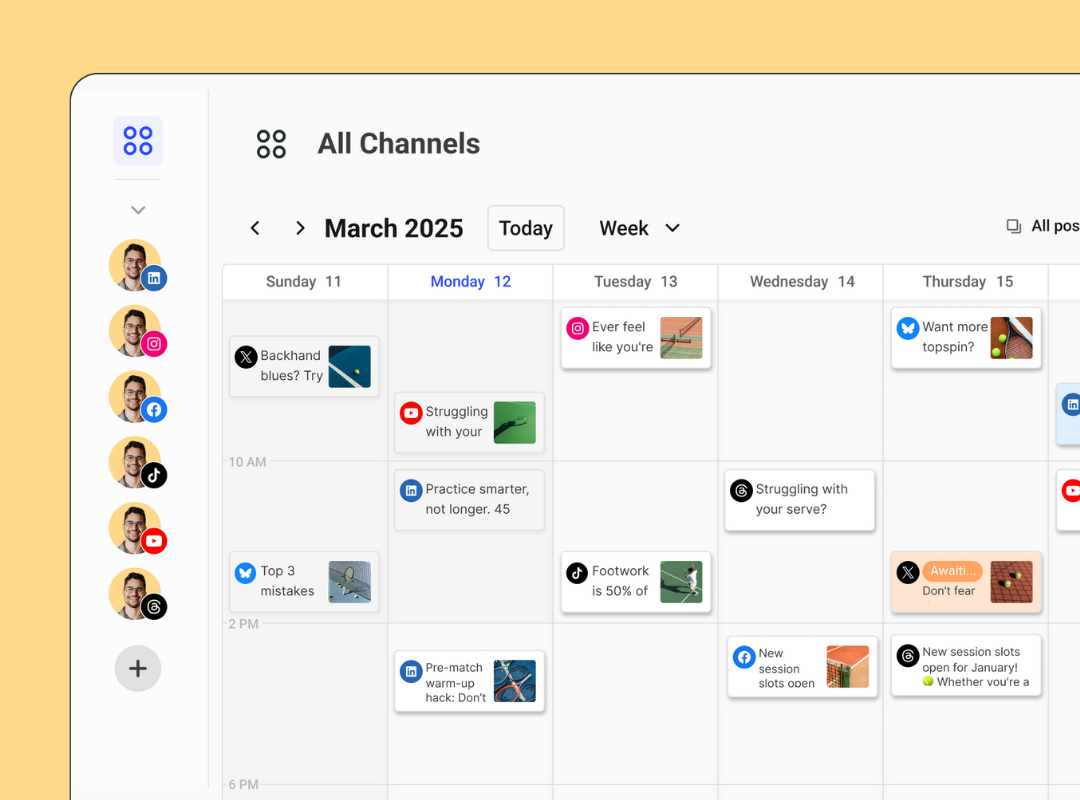
Buffer’s visual content calendar also gives you a bird's-eye view of what's coming up, helping you spot the content gaps you need to fill.
6. Find your best times to post on Instagram
Posting when your followers are online gives your content a better shot at more reach. More reach means more chances to attract new followers.
According to our analysis of over two million Instagram posts, the best time to post on Instagram is generally between 3 p.m. and 6 p.m. on weekdays.
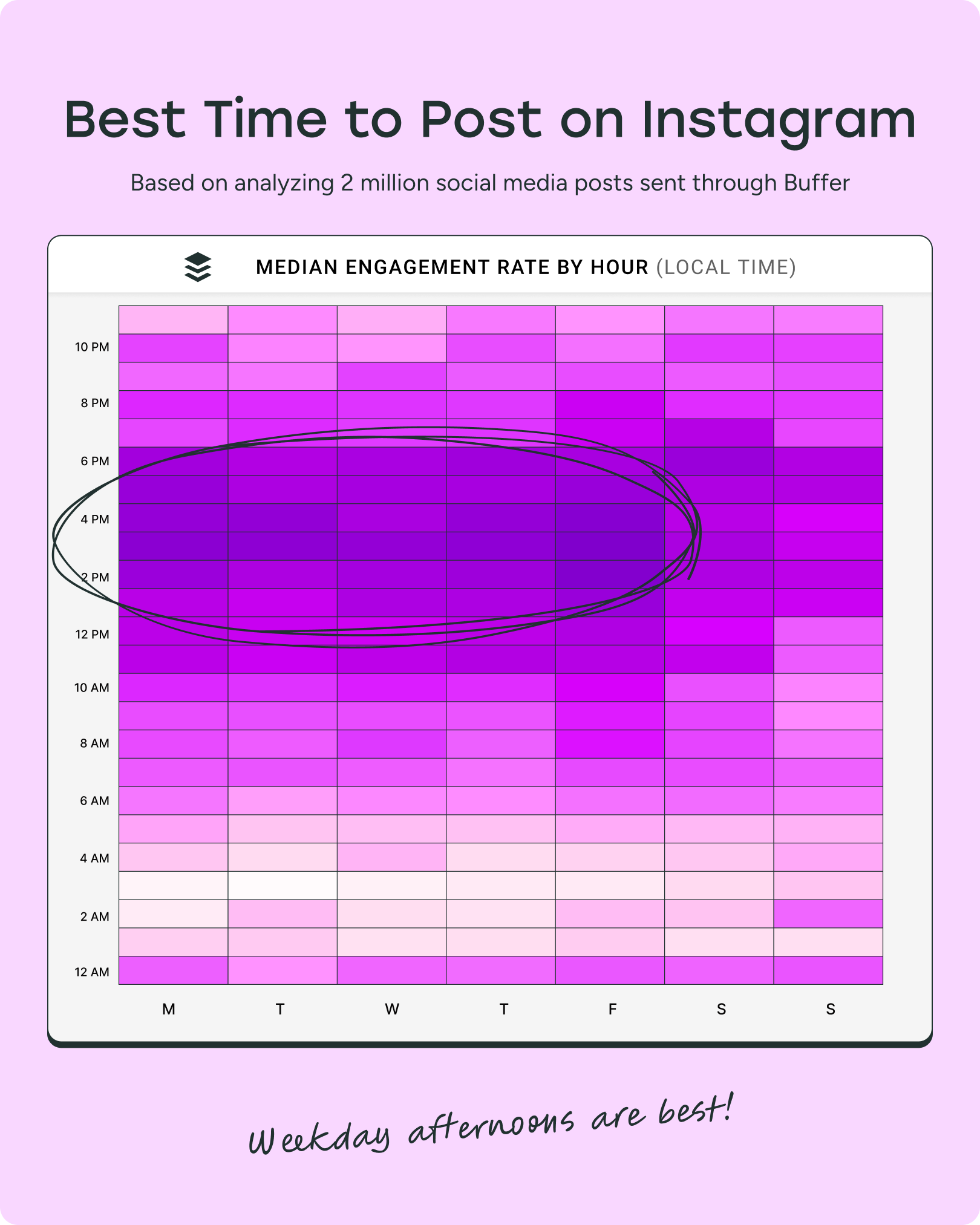
If you want to dig deep into the numbers and how we arrived at these times, check out our YouTube video:
But if you want to understand when your followers are online, Instagram insights can tell you that in four simple steps:
- Open your Instagram app and navigate to insights using the hamburger menu (the three horizontal lines) on your account. If you’re on Instagram web, just click on “Dashboard.”
- Click on “Total followers” if you’re on the Instagram app or select “Account” if you’re on the web.
- Scroll down to the bottom of this page and look for “Most active times” to understand when your Instagram followers are online. You’ll be able to toggle between hours for every day of the week or look at specific days.
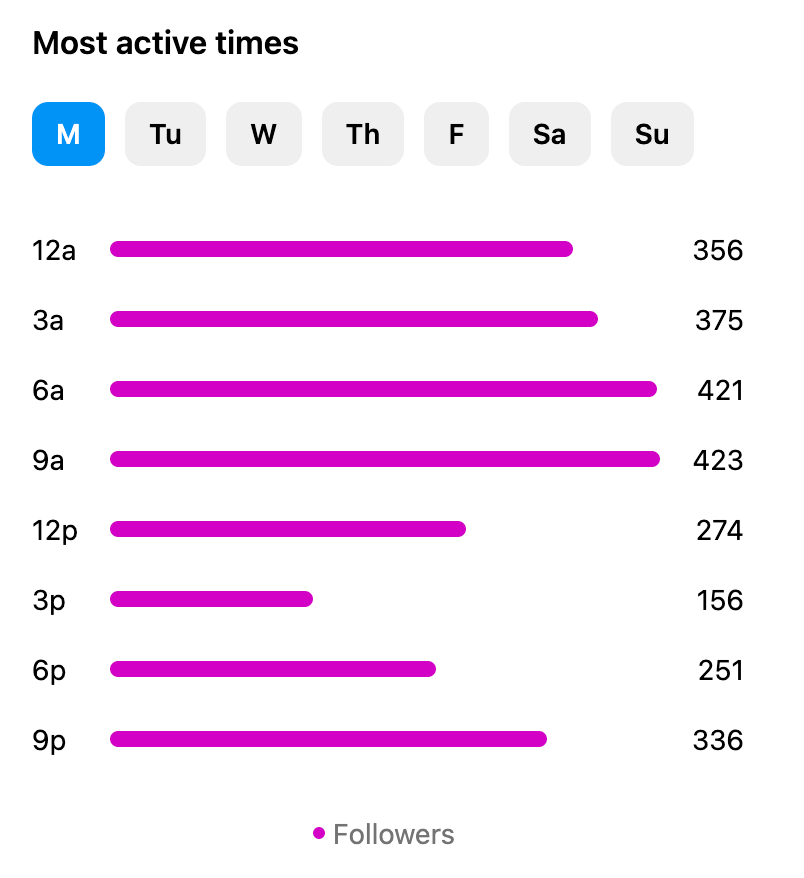
Want to take it up a notch? Use Buffer’s analytics to determine the best times to post, the best types of posts, and the best post frequency — all in one tab.
Buffer uses data from your previous posts and followers’ activity and organizes the numbers in a way that’s easy to understand.
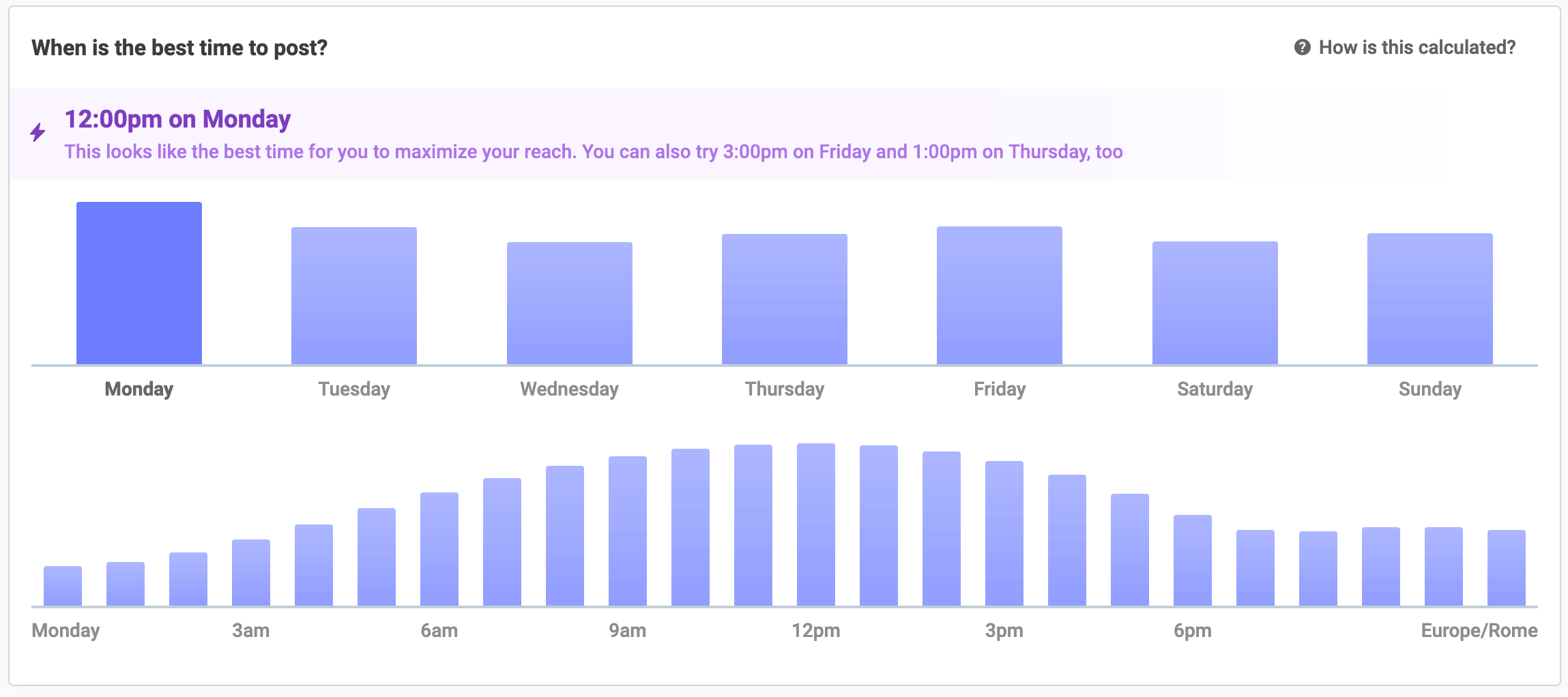
Along with the time, also consider when your Instagram posts would be more relevant logically.
A step-by-step video recipe will perform better after working hours when people cook. On the other hand, coffee shop Instagram Stories might do better at the 2 p.m. afternoon slump.
Experiment with posting times to determine when you reach new audiences (and gain new followers!).
Now we’re moving on from the fundamental tips into intermediate territory. We recommend completing steps 1 through 6 before tackling the rest of this list.
7. Write compelling captions
It’s enticing to skimp on Instagram captions when you’ve toiled to create the perfect carousel or video. But Instagram captions hold more weight than you think: They can either nudge someone to follow you or scroll past you without looking.
Plus, the longer someone lingers on a post — particularly a reel — is a strong signal to the Instagram algorithm that your content holds value. So give folks something to read.
For example, wellness brand Cosmix doesn’t simply write, “shop on our website!” on its Instagram posts. It explained the ingredients used, how Cosmix products help specific issues, and mentions the studies that back up these claims.
Writing the perfect Instagram caption is about understanding your audience and the context of your post. If you’re writing an educational post, it makes sense to have a longer caption. But when you’re sharing an aesthetic product image, shorter is sweeter.
Similarly, also think about captions based on content formats: Instagram Stories need a shorter caption (or text on media) because your followers view them quickly, but carousel posts might need more context.
If coming up with cheeky captions isn’t your forte, try Buffer’s AI assistant to generate a rough first draft in seconds.
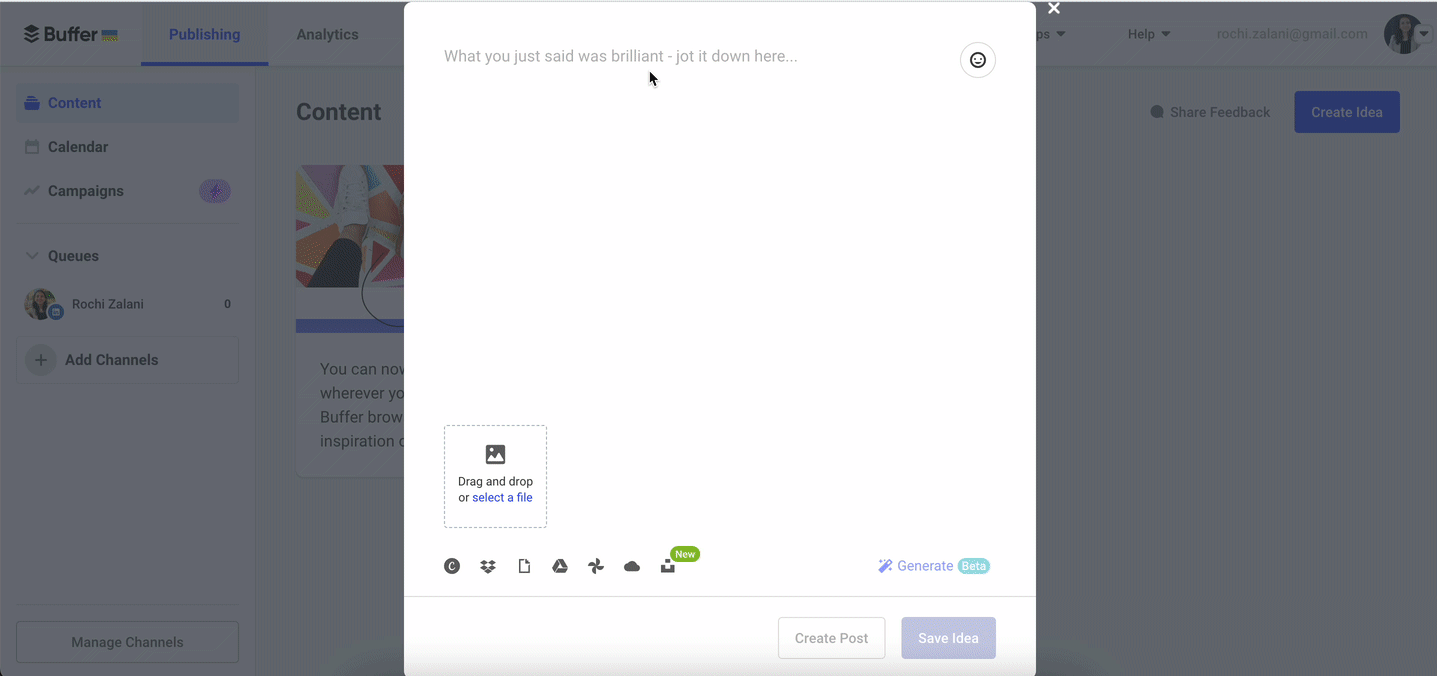
If you need more inspiration, Buffer also has a free template library to help you scour through hundreds of ideas for your captions and posts. You can also filter them based on post type (hot take, opinion, promotion, etc.), goal, format, and creator type (individual vs. business).
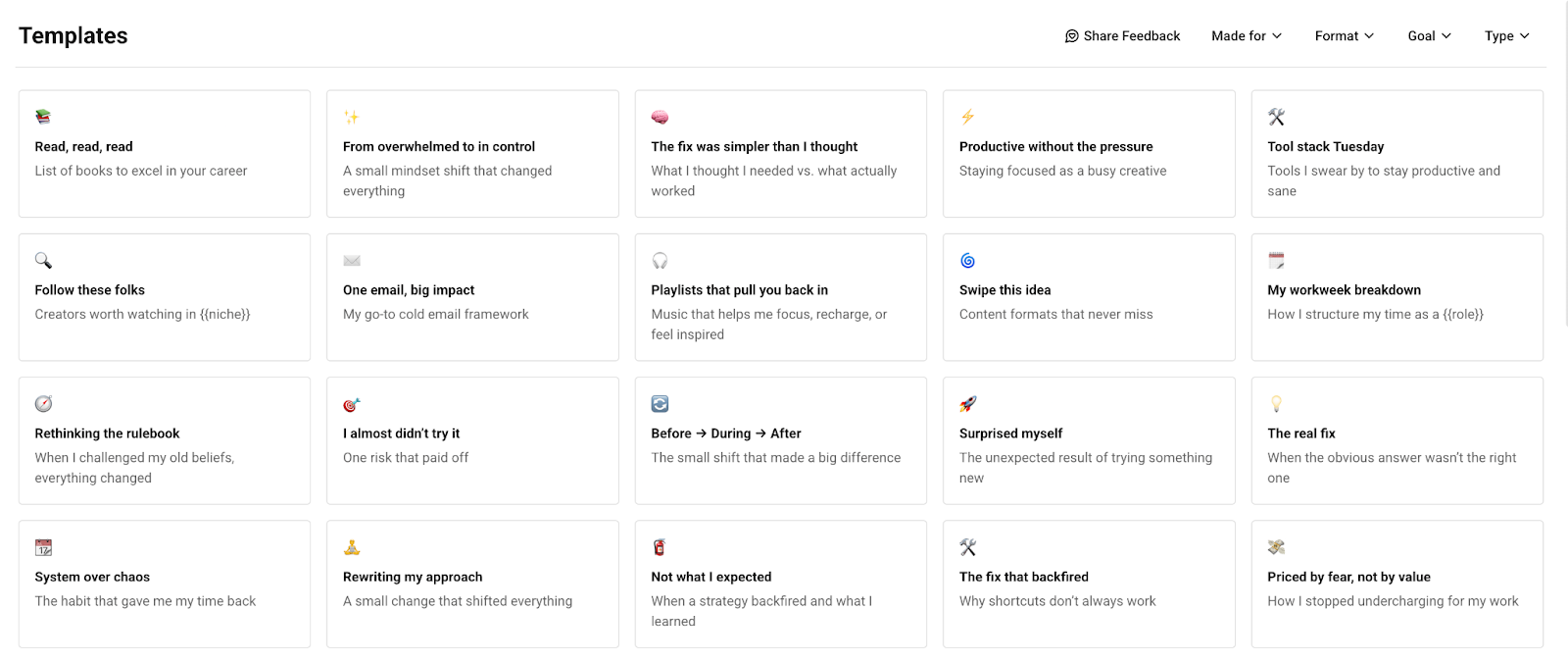
Whenever you’re in a creative slump about what to post and how to write a captivating caption, just go on to the template library and scroll until you find something interesting you can use!
8. Use relevant hashtags, locations, and keywords
People often search for relevant keywords, hashtags, and locations to find the type of content they’re looking for. If you rank for these searches, you expose your Instagram content to potential followers.
Keywords
Use keywords related to your post (without stuffing them). Think of the phrases and words your audience might be using to search for the type of content you’re creating. Instagram picks up keywords from captions, visuals, and hashtags — so use the relevant keywords in all these places.
How do you find the relevant keywords? Run a search for the phrases you think your audience might use and see which keywords other brands are using. Instagram will also fill in related terms when you search for a broad keyword, just like on Google.
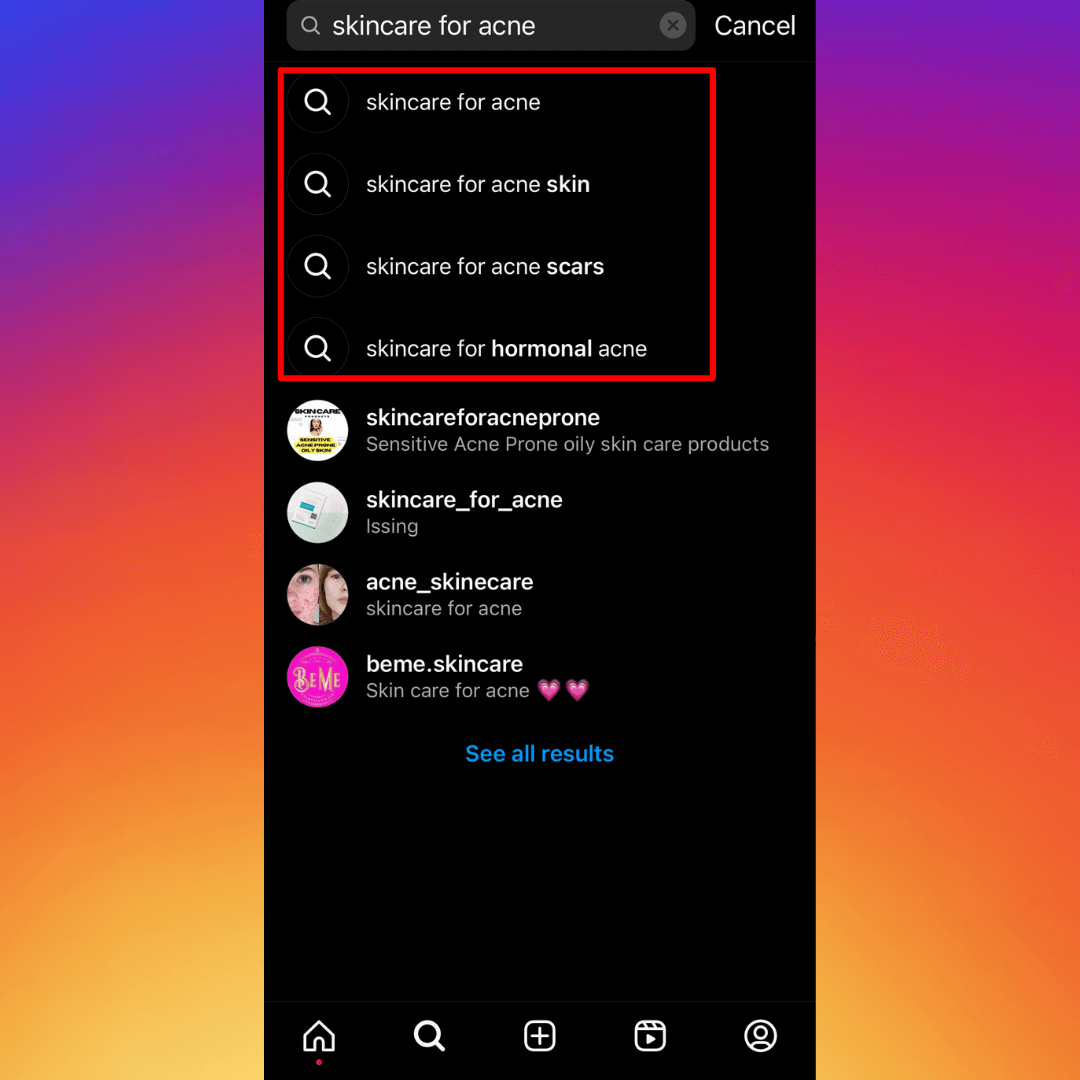
Hashtags
How many hashtags should you use? Instagram recommends using three to five relevant hashtags with every post. Mix popular and niche hashtags to increase your chances of ranking on the Explore page when someone searches for the hashtags in your niche. This will allow you to make the most of Instagram hashtags without cluttering your posts.
How do you find relevant hashtags? You can search niche hashtags to find popular Instagram hashtags related to your posts. You can also use hashtag generators like Buffer’s free hashtag generator to find relevant hashtags.
Simply share what your post is about, click on “Generate hashtags,” and Buffer will share a list of hashtags you can use.
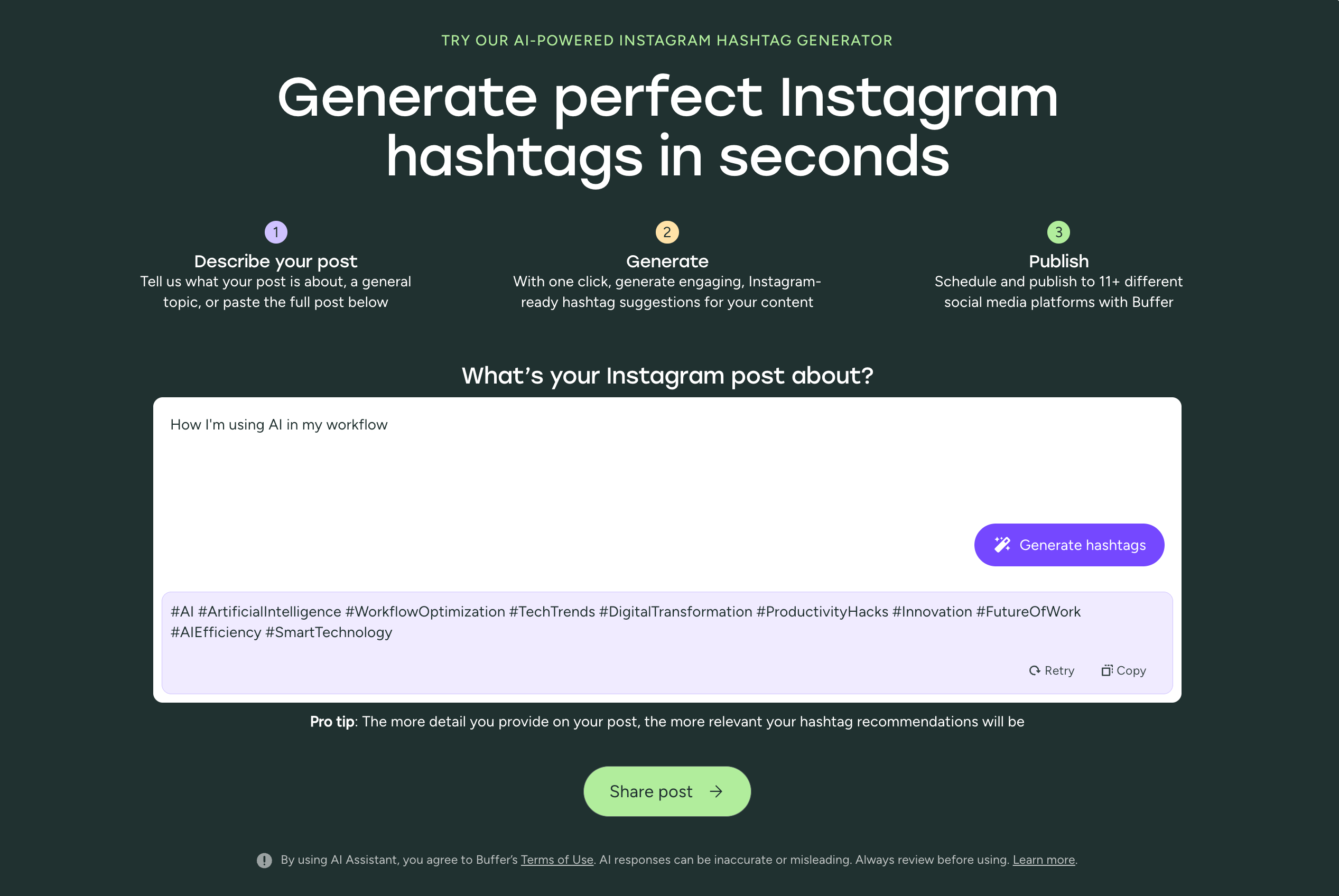
Buffer can also help you curate a list of hashtags and organize them into groups using the hashtag manager. For example, make a group of product-specific hashtags and another for niche or industry-specific hashtags. Select from your pre-saved groups on Buffer and add hashtags to your scheduled Instagram posts with one click.
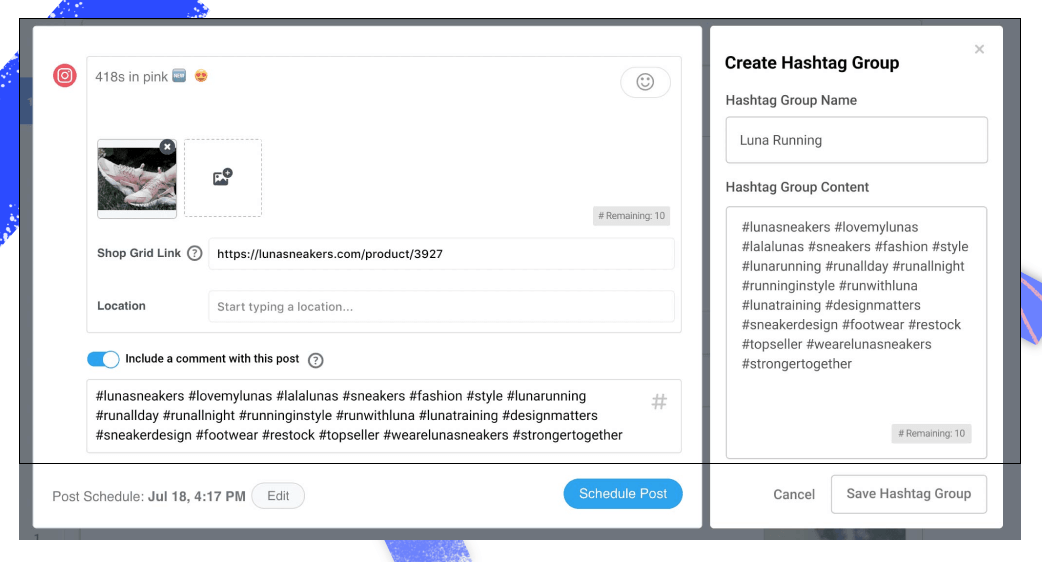
Location
For local discovery, add in a geotag as well. Tagging your city, neighborhood, or event space helps Instagram surface your post to people browsing that location — a simple step that can land your content on the Explore page for nearby users. This might also help your content surface in followers’ Friends Maps.
9. Understand your analytics
Regularly checking your Instagram analytics is key to understanding what’s helping you get more followers on Instagram.
You might find that your audience responds best to entertaining reels, but educational posts work best as carousels. Maybe you discover Instagram giveaways are best for engagement, but they don’t help you gain followers.
Instagram has native analytics on its app, but they’re pretty limited. You can’t see your individual posts’ performance in a single window to analyze them side by side, nor can you handpick metrics important to you.
It’s better to use a third-party tool like Buffer’s analytics to get all the data at a glance and even make custom reports for stakeholders.
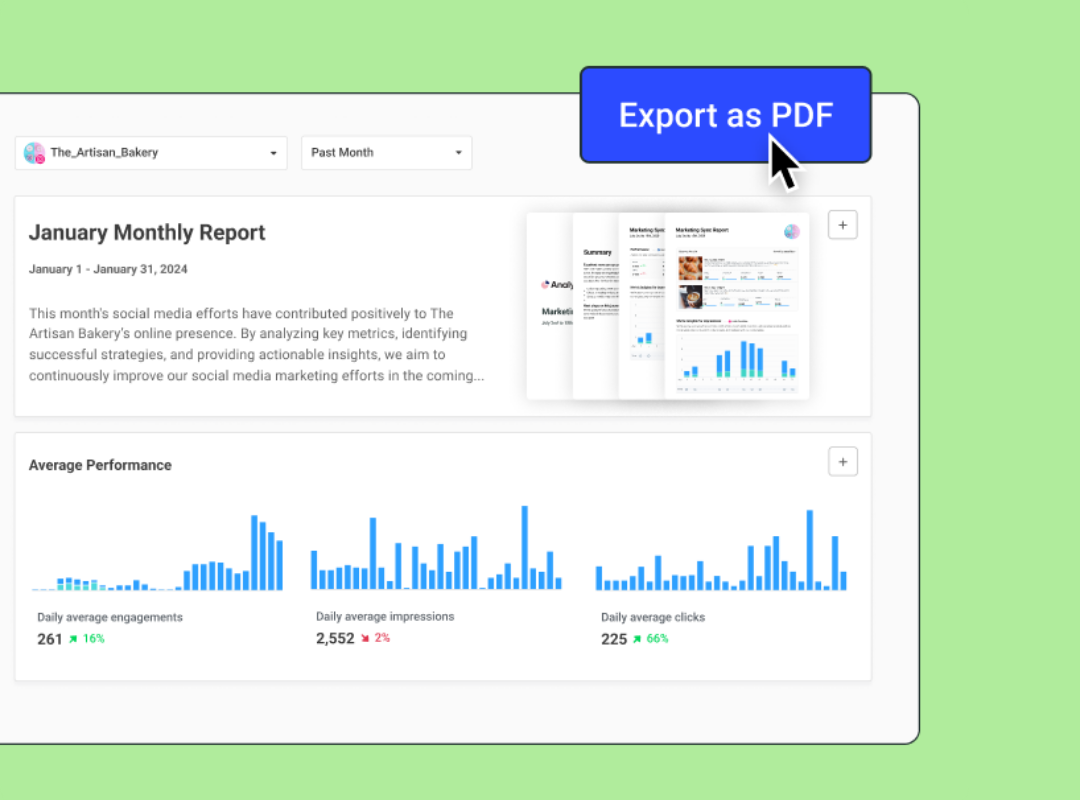
Which metric is the most important to track? It depends on your Instagram goals and strategy. For example, if you’re testing a new hashtag, knowing the number of new followers is more important than tracking likes from your current followers.
But if you’re experimenting with posting times, keeping an eye on impressions is more important.
Mosseri says reach is probably the most important metric to track on Instagram for growth. “If you're trying to understand why your reach is what it is, the things to look at most are likes per reach,” he says. “If a thousand people saw it, how many liked it?”
“[Then comes] sends per reach. And if you're posting a video, average watch time. Those three metrics matter the most.”
10. Collaborate with Instagram creators or other small businesses
Collaborating with other creators or small businesses doesn’t just double your reach. It also helps you connect with new audiences who are already interested in your niche.
Instagram collab posts with other creators via influencer marketing or partnerships with small businesses are a win-win because they expose both parties to potential Instagram followers.
The critical bit is ensuring you partner with a company or creator who aligns with your values and whose followers’ demographics and interests overlap with your target audience.
For example, the period tracker app, Flo, collaborated with Charity Ekezie and created a paid Instagram post to highlight the company’s social initiative to offer premium features for free in countries like Ethiopia and Haiti.
These posts are shown on both accounts — meaning all followers of your creator partner will see the shared post (and, by extension, your Instagram profile and small business).
If influencers with over a hundred thousand followers are out of your budget, run a micro-influencer campaign. Smaller creators often have a tightly-knit community that trusts their recommendations.
How to find these influencers? You can go through a manual Google search or search using hashtags and keywords on Instagram. A smarter approach is to use influencer discovery tools like Modash to save time and find relevant creators.
It’s not necessary to restrict yourself to partnering with individual creators. You can also form partnerships with other small businesses. Take a look at how LinkedIn and Headspace collaborated to create a post about recovering from job loss.
Collaborating on Instagram doesn't only mean creating a shared post, either. You could also:
- Go live with a creator
- Do an Instagram account takeover
- Repost Instagram content from an influencer’s profile to your Instagram stories
- Post videos created by them natively on your brand account (with permission!)
11. Experiment with different types of Instagram posts
It's been a long time since Instagram was just a photo app. The platform has introduced many formats, including short-form video content like reels, stories, and carousel posts.
Which type of posts will help you boost engagement and gain more followers? Buffer’s analysis of over 4 million posts found Instagram reels get 36% more engagement than other post types.
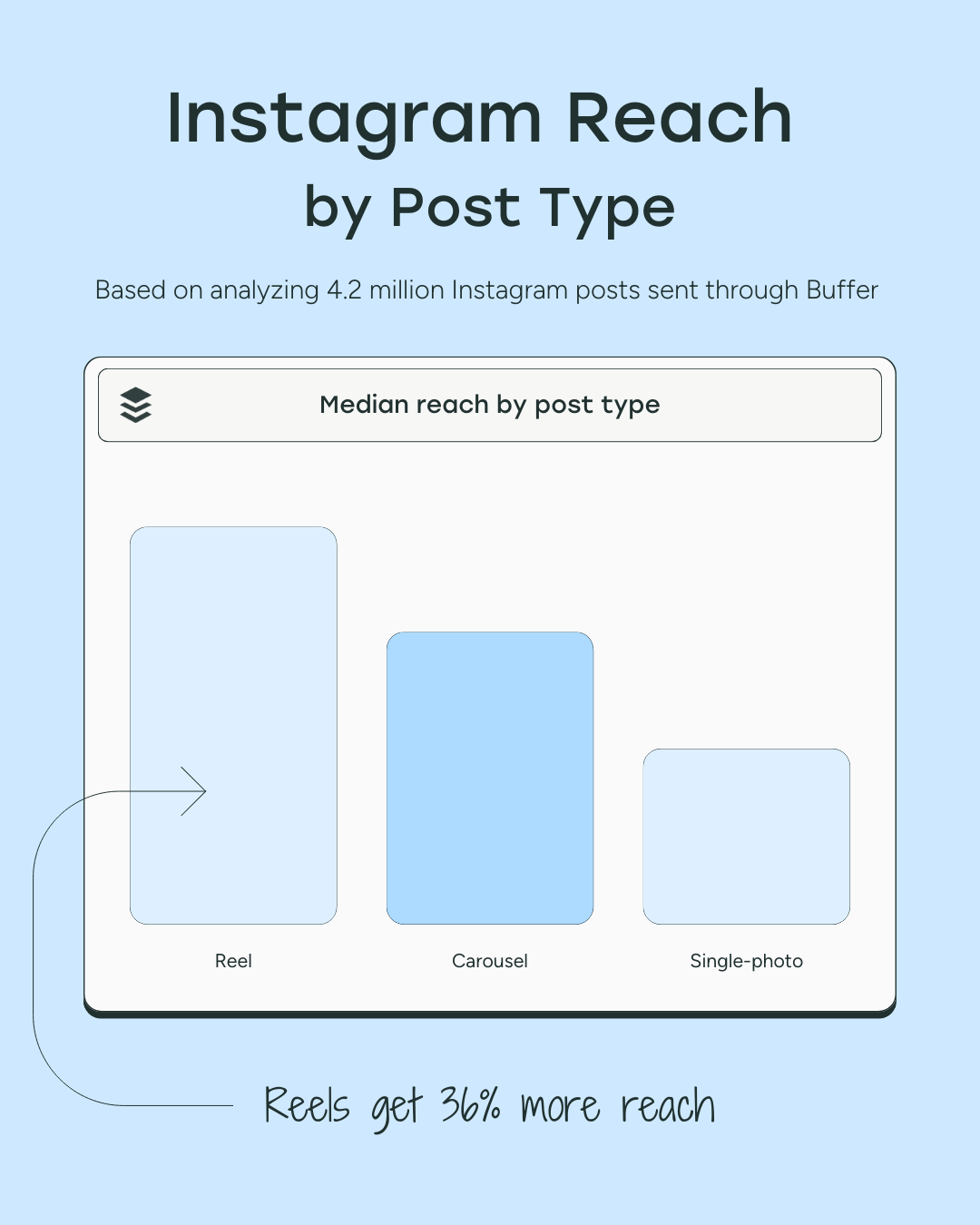
Mosseri has confirmed that Instagram reels get more reach. He’s also advised against using watermarks/logos and reels longer than three minutes, as they get less reach.
But remember, reach isn’t the same as engagement. Our research — the same one that found reels get the most reach — also found that carousels get 12% more engagement than other content formats.
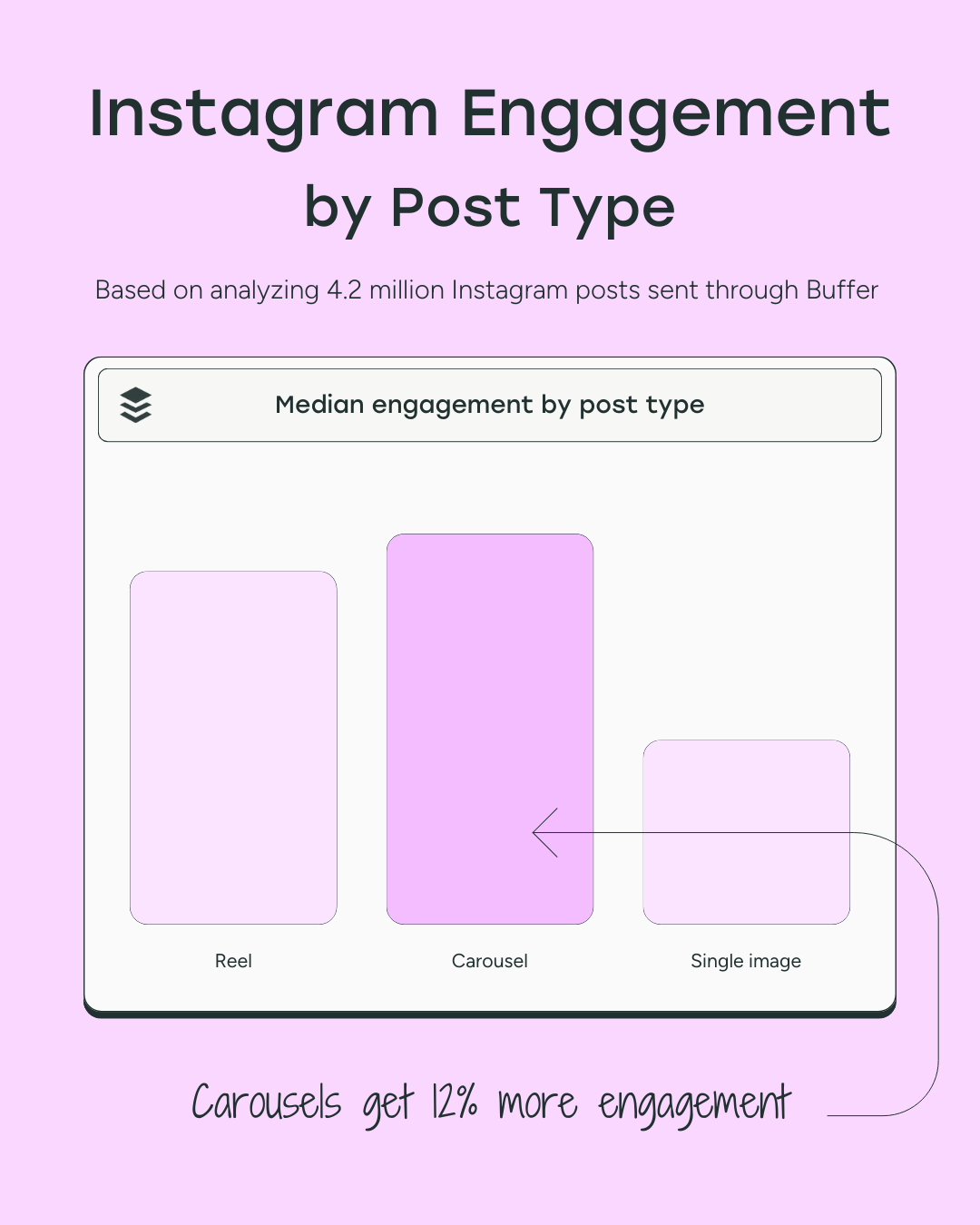
It’s likely because carousels have more chances to show in users’ feeds. They might have swiped to three photos and left — so Instagram will show that post again to help them pick up where they left off.
The bottom line: Experiment with all content formats of Instagram to check which post type is best for what kind of content.
For instance, reels might be best for entertaining bite-sized content and getting more Instagram followers. Carousels might be best for in-depth educational content and keeping your existing followers engaged.
Use Instagram’s Trend Report and their creator account to keep a pulse on the Instagram algorithm and the new trends. Trial reels are the best way to experiment with your content and reach new audiences at the same time.
Speaking of different post formats: don’t sleep on Instagram Live. Going Live sends a push notification to followers, places you first in the stories row, and lets you answer questions in real time. Try a fifteen-minute Q&A, a product unboxing, or co-host a Live with a creator in your niche to tap into their audience, too.
12. Talk to your audience in comments and stories
Social media is a two-way street. When you engage with your followers — whether that’s via interactive Instagram stories or responding to their comments — you build a stronger sense of community and improve your brand reputation.
Remember: Getting more Instagram followers isn’t just about adding new followers; it’s also about maintaining your follower count. You don’t want to lose your existing community because you’re unresponsive.
The yogurt brand Chobani is a good example. They respond to almost every comment they receive.

Responding to every comment might be unrealistic once you start receiving thousands of them (good problem to have!), but do your best to respond to as many queries as possible.
Buffer’s Community feature make it easy to respond to all comments from all your platforms, right there on the Buffer dashboard. You can set up notifications, filter and sort your comments, and even create a new post from a reply.
Stories also have plenty of interactive features — like question stickers, polls, countdowns, etc. — to help you interact with your IG followers and keep your audience engaged.
For example, nutrition brand Bulletproof does a weekly Q&A on its stories to answer frequently asked questions about its products.
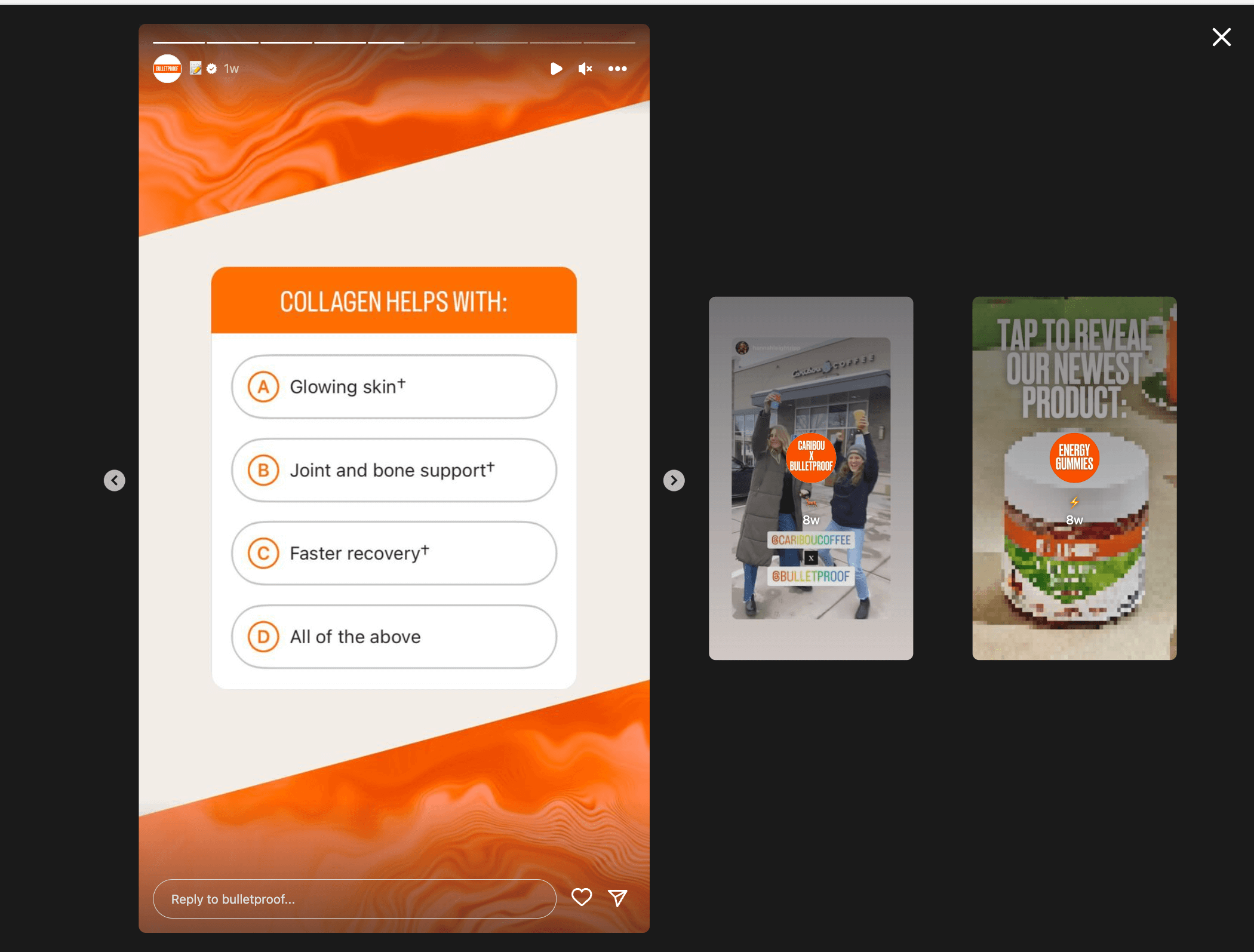
Stories are perfect for behind-the-scenes clips or quick polls because they sit at the very top of the app. But their 24-hour lifespan can feel limiting, so bring your best ones back to life with Story Highlights.
These mini playlists live permanently on your feed, giving new visitors an easy way to binge your top content.
Use them to create a go-to resource section answering all common customer queries to reduce the friction in selling your products on Instagram.
Some more Instagram Story Highlight tips:
- Create “Start Here” or “FAQs” Highlights to answer common questions.
- Group product demos, tutorials, or testimonials into their own collections.
- Use a consistent cover design so your highlights look neat and on-brand.
13. Avoid buying followers
It’s tempting to buy Instagram followers to inflate your follower number. But it’s worth remembering that fake followers aren’t going to interact with your Instagram profile.
They’ll either be bots or fake accounts — not real Instagram followers (and definitely not relevant ones). So your follower count might soar, but your engagement rate will plummet.
Fake Instagram followers also hurt your credibility. Potential collaborators and your audience will sooner or later get suspicious of the mismatch between your number of followers and engagement rate. This can make your audience lose trust in you and harm your personal brand in the long term.
If that wasn’t enough, the Instagram algorithm also pushes posts with authentic engagement. The platform might penalize you for disguising fake accounts as real followers.
14. Get verified on Instagram
Having the coveted blue checkmark next to your Instagram account is a badge of instant credibility. It helps you stand out in search results, avoids impersonation, and even get higher engagement rates.
If your aim is to increase your Instagram growth rate, getting verified will undoubtedly help.
But how do you get verified on Instagram? Don't worry if you're not famous — the blue-check is no longer exclusively resevered for public figures.
The easiest way is to buy a subscription through your Instagram profile. (There are certain eligibility requirements you have to meet, like adhering to Meta’s minimum activity requirements, but that shouldn't be hard.)
Getting more followers on Instagram isn’t a one-time affair
With these 14 tips under your belt, you’re certainly more equipped to get more followers on Instagram.
But it isn’t a one-and-done deal. Maintaining Instagram growth requires regularly publishing high-quality content and staying on top of your social media strategy.
It’s time-consuming and laborious to manage the planning, posting, engaging, and tracking manually. Having an all-in-one tool — like Buffer — lets you do all of that under one roof. Don’t take just my word for it: Get started for free today and see for yourself.
Frequently asked questions
How can I get my first 1,000 followers quickly but organically on Instagram?
Focus on content that people want to share. Post short, engaging reels, use clear keywords and a handful of relevant hashtags, and add strong calls to action in your captions. Comment on posts in your niche, reply to every comment you receive, and cross-promote your handle on other platforms. A steady posting schedule —made easier with a tool like Buffer — helps you show up in the feed more often and reach new people faster.
What is the 5-3-1 rule on Instagram, and does it work?
The 5-3-1 rule is a daily engagement habit: like five posts, leave three thoughtful comments, and follow one new, relevant account. The goal is to spark genuine conversations so more people check out your profile and follow you back. It’s simple, free, and a good way to build community — as long as your interactions stay authentic and on-topic.
How often should I post if I want to grow my follower count?
Most accounts see steady growth when they share around three to five high-quality posts per week and a few stories in between. Mix formats — reels for reach and carousels for deeper engagement. Check your Instagram Insights (or Buffer analytics) to learn when your audience is online, then stick to a schedule you can keep up with long-term.
More Instagram resources
Try Buffer for free
190,000+ creators, small businesses, and marketers use Buffer to grow their audiences every month.




